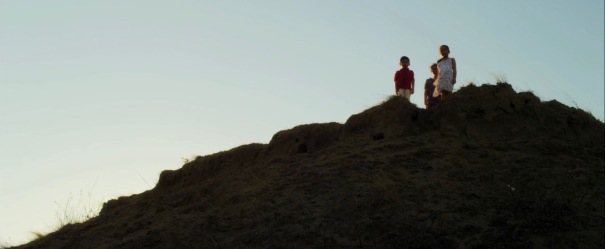
A disclaimer to start off:
I have personally become disillusioned with the American critical stance of films having to have a certain time-frame of “watchability”. I don’t get that. To me, a film’s “length” being indicative of its watchability only really depends on the seriousness of the filmmaker. If there is, in the filmmakers judgement and intellect, truly a necessity for the runtime he has allotted for his film, then I leave that to his discretion. The nonsensical argument that a movie lasting more than 2 or 2 ½ hours is one which is poorly edited is a myth, and it’s a myth which has ruined films like Ridley Scott’s Kingdom of Heaven, forced Tarantino to chop Kill Bill into two parts, and made the 4 ½ hour version of Peter Jackson’s Lord of the Rings: The Return of the King be restricted to DVD instead of where it really belonged: in the theater. Yet, evidence exists everywhere of films with lengthy run-times that have gripped me far more and relentlessly than even 90-minute features.
One of them, Lav Diaz’s 4 ½ hour Norte, The End of History is in a word, incredible. Incredible to behold in not only its cinematic scope of location, camerawork, and time, but equally in the density of its core, packed with so many discussions of socio-politics, religion, and the fight between immorality, innocence, revenge, and love so jam packed one after another with so many ideas and insights into the film, that its 4 ½ hour runtime doesn’t feel even a millisecond “too long”. There wasn’t a moment of this movie which made me check what the time was, on my watch or my phone. I was glued. From the opening scene discussing a provocative conversation of nihilism, dictatorship, we are automatically drawn to the upstart law student Fabian, who’s radical ideologies, Marxist level of disdain for the economic and social state of his nation, The Philippines. This may not seem riveting to the average film-goer, but I am a sucker for philosophical discussion, especially one in which fervor and anger take central stage, because it displays the passion for socio-politics that I think everyone in every country could benefit from in a knowledge standpoint and one of inspiration.

Diaz is clearly speaking to the effects of the nation on its populace and in turn, the reaction of its citizens throughout the film. While Fabian’s disillusionment leads him down a dark and horrifying path of self-hatred, poor construction worker Joaquin and his family (wife and 2 kids) lead a life of quiet desperation, going about their daily chores, living hand to mouth, not saying much because they don’t have the power nor the energy to do so. The two threads that made up the quilt of Norte are weaved in the winding lives of Fabian and Joaquin. The distinction between their two lives is important, the former a brilliant prodigy of the law student praised by his teachers as an “outside thinker” and the other a low wage worker at the bottom of the totem pole, a mule of the economic system. As Fabian commits a gruesome murder, one sparked by both a sense of righteousness and blind hatred, Joaquin is the one who bares the brunt of the blame, a perennial scapegoat of the corrupt, a “disposable entity”.

The irony at face value of course is that in his Raskolnikovian guilt and shame, Fabian lives in his own prison outside of the bars, while Joaquin in jail is shown to grow as a person and his kindness succeeds in winning over even the coldest of hearts. But Diaz’s commentary goes a bit deeper than this, as a 4+ hour film should. We realize that Fabian’s existence as a disillusioned youth was his prison, and his murder was already a murder committed behind bars. For him, the Philippines itself was the prison, a nation which, from the beginning of the film itself, was at the precipice of complete hopelessness according to Fabian, one where every transgression deserved a murder, every political lie deserved torture. His anger at the socio-political turmoil which surrounded him infiltrated his mind and ignited the fire of a young would-be dictator. One teetering between the heart of a good kid wanting so much better for the people of country (he gives up all his saved money to Joaquin’s wife for her to keep and raise her kids with), and a madman who’s helplessness in the grand scheme of things leads him to violent insanity.

To me, Diaz’s ultimate message in this film was that the oppression and neglect of a ruling government can be directly related to rise of violent and immoral individuals. The lack of power, the lack of solutions, and the continued boiling anger of a population can produce a Fabian, and it can also hamper a Joaquin. There is unforgiving heartbreak, death, rape, and torture which is peppered throughout the film, but none of it is disingenuous, or manipulative, or politically preachy. It is showcased as a happenstance of life in a country where Diaz clearly believes so much to be morally wrong. A country where the populace is devoted to God, where Jesus and Catholicism and priesthood are such a prevalent part of the culture, yet, Godless acts seem to occur, without much mourning.
Readers know from a few of my previous articles, that I am very averse to labelling a film a masterpiece because I always feel like I’m short-changing the power of that word. We use it so loosely (just like everything else today) and freely that I feel the need to be even more strict with my usage of it to counter the complete liberal abandon with which it is being flung around nowadays. But I thought about it, I pondered it, and I spent the better part of the last month letting Lav Diaz’s Norte, The End of History sink in. I am at a loss for another word to describe my experience with this movie. Masterpiece, it is.
(Suffice to say, I will be watching more Lav Diaz in the coming months, starting with From What is Before…. Stay tuned!)





